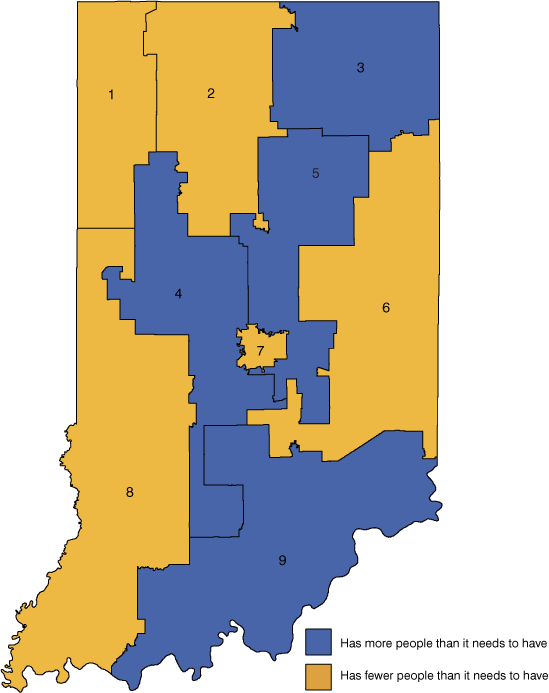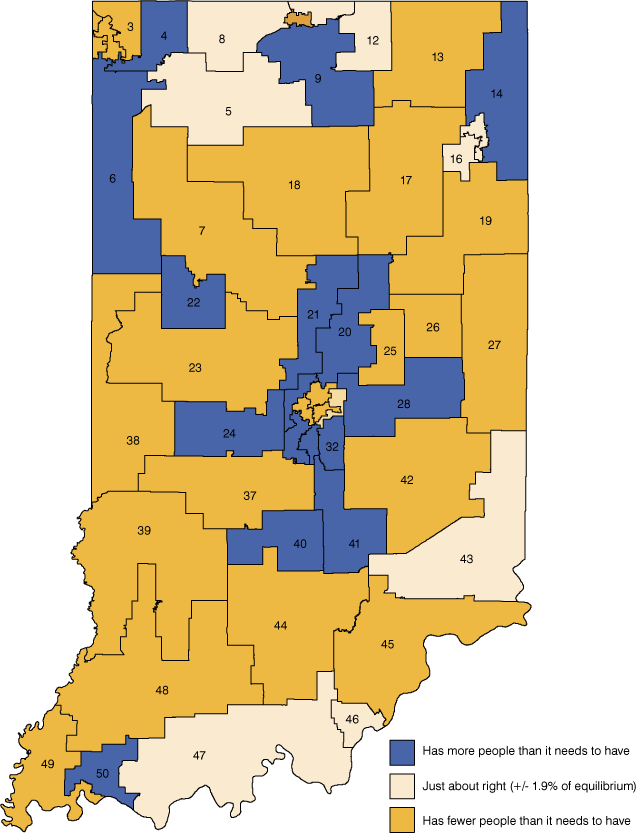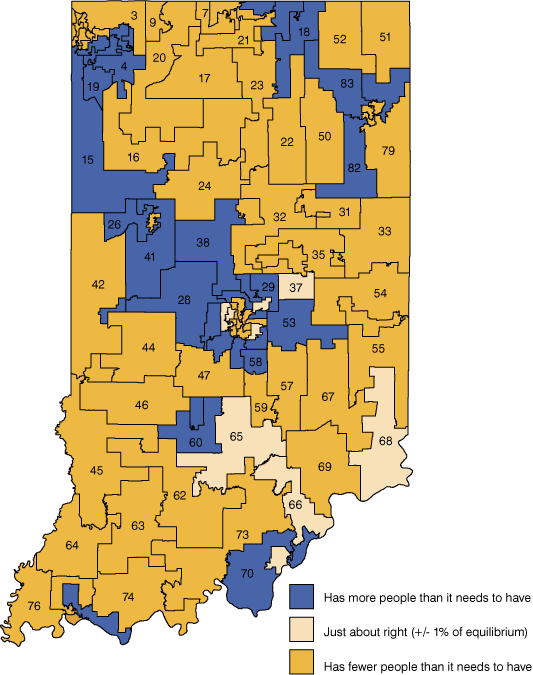Uneven Population Growth Means Significant Changes Ahead for Indiana's Legislative Districts
Indiana's population grew 6.6 percent between 2000 and 2010, but the growth was not evenly spread throughout the state's legislative districts. Because the law requires districts to be of roughly equal population, districts are likely to see changes to their boundaries during the current round of redistricting.1 This analysis highlights the population shifts between 2000 and 2010 and shows which congressional and Indiana General Assembly districts will need to grow or shrink geographically to meet the equal population criteria.
Congressional Districts
Indiana has nine congressional districts and each one should contain 720,422 people as of the 2010 Census (this is up from the equilibrium point of 675,609 after Census 2000). As Figure 1 shows, four districts now have too many people, while five have too few residents.
Figure 1: Congressional District Population Relative to the Equilibrium Point of 720,422 Residents, 2010

Source: IBRC, using U.S. Census Bureau data
Congressional District 5 experienced the largest population change when looking at both numeric change (+133,530 residents) and percentage change (19.8 percent). It now exceeds the target equilibrium population by nearly 89,000 people.
None of the congressional districts declined in population, but Congressional District 7 had the smallest growth (only 677 residents, or 0.1 percent). In order to reach the target equilibrium population, it would need about 44,000 more people.
Indiana Senate Districts
The Indiana General Assembly has 50 senate districts and each one should contain 129,676 people as of the 2010 Census (this is up from the equilibrium point of 121,610 after Census 2000). As Figure 2 shows, 17 of the current districts have too many people, while 24 have too few residents (the remaining nine districts fall within 1.9 percent of the equilibrium population—that was the acceptable level of population variance after the 2000 census).
Figure 2: Senate District Population Relative to the Equilibrium Point of 129,676 Residents, 2010

Source: IBRC, using U.S. Census Bureau data
Looking at both ends of the spectrum, Senate District 28 (which includes Fishers, Fortville, Greenfield and New Castle) grew the most, increasing by 41.4 percent (+50,099 residents). It now exceeds the target equilibrium population by more than 41,000 people.
Twelve senate districts had a population decline between 2000 and 2010. Senate District 34 in Indianapolis experienced the largest decline (-17,011 residents, or -13.8 percent) in the state, followed closely by Senate District 3 (-16,302 residents, or -13.6 percent), which includes Gary, Lake Station and Hobart. In order to reach the target equilibrium population, both of these districts would need to add more than 23,000 people.
Indiana House Districts
The Indiana General Assembly has 100 house districts and each one should contain 64,838 people as of the 2010 Census (this is up from the equilibrium point of 60,805 after Census 2000). As Figure 3 shows, 30 of the current districts have too many people, while 62 have too few residents (the remaining eight districts fall within 1 percent of the equilibrium population—that was the acceptable level of population variance after the 2000 census).
Figure 3: House District Population Relative to the Equilibrium Point of 64,838 Residents, 2010

Source: IBRC, using U.S. Census Bureau data
House District 29 (which includes Noblesville and Fishers) grew the most, almost doubling at 94.5 percent (+57,524 residents). It now exceeds the target equilibrium population by more than 53,000 people.
Thirty house districts experienced population decline between 2000 and 2010. House District 14 (including Gary and Lake Station) experienced the largest decline (-11,872 residents, or -19.3 percent). In order to reach the target equilibrium population, this district would need to add more than 15,000 people.
Summary
While the General Assembly is working during this legislative session to re-draw district boundaries, you can visit STATS Indiana for more analysis of how the current districts have changed since 2000 in the form of interactive maps, district profiles and data extracts.
Notes
- It wasn’t until 1964 that the Supreme Court codified the “one person, one vote” principle, which requires that districts be of equal population. The Wesberry v. Sanders decision that year applied equal population requirements to congressional districts, while the Reynolds v. Sims case applied it to state legislatures.
Rachel Justis
Geodemographic Analyst, Indiana Business Research Center, Indiana University Kelley School of Business
